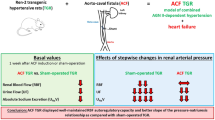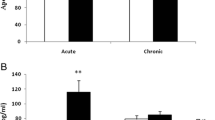Abstract
A study was made of the vascular protein synthesis in young, genetically hyper tensive rats, mainly in their renal arteries. Some of the rats were treated either with 3.5 mg/kg of phenoxybenzamine (POB) or with 4 mg/kg of propranolol twice daily, from 6 to 8 weeks of age.
3H-proline was injected intravenously into each rat before sacrifice to analyse thein vivo incorporation rates of tritiated proline into the vascular collagen and vascular non-collagenous proteins.
Evidence has been presented that: (1) the rates of incorporation of3H-proline into collagen and non-collagenous proteins of the renal arteries in spontaneously hypertensive rats (SHR) and stroke-prone spontaneously hypertensive rats (SHRSP) were greater than those in normotensive Wistar Kyoto rats (WKY); (2) the administration of POB decreased incorporation of3H-proline into the collagen and non-collagenous proteins of the renal arteries concomitant with a reduction of blood pressure in every rat strain; (3) the administration of propranolol failed to decrease the incorporation of3H-proline into these connective tissue proteins in the renal arteries and this drug did not reduce blood pressure in every rat strain; (4) the incorporation rates of3H-proline into these protein fractions in hearts were similar in every rat strain which received any drug treatment.
These results indicate that an increased synthesis of collagen and non-collagenous proteins in the renal arteries of young SHR and SHRSP rats participates in the pathogenesis of spontaneous hypertension in the early hypertensive stage.
Similar content being viewed by others
References
Armstrong, M. L., Megan, M. B.: Arterial fibrous proteins in Cynomolgus monkeys after atherogenic and regression diets:Circ. Res., 36, 156 (1975).
Fitch, S. M., Harkness, M. L. R., Harkness, R. D.: Extraction of collagen from tissues.Nature, 176, 163 (1955).
Folkow, B.: The hemodynamic consequence of adaptive structural changes of the resistance vessels in hypertension.Clin. Sci., 41, 1 (1971).
Katholi, R. E., Winternitz, S. R., Oparil, S.: Decrease in peripheral sympathetic nervous system activity following renal denervation or unclipping in the one-kidney one-clip Goldblatt hypertensive rat.J. Clin. Invest., 69, 55 (1982).
Kawabe, K., Watanabe, T. X., Shiono, K., Sokabe, H.: Role of the kidney in the pathogenesis of SHR, and other hypertensive rats determined by renal isografts.Jap. Heart J. 20, [Suppl. 1], 87 (1979).
Lowry, O. H., Rosenbrough, N. J., Farr, A. L., Randall, R. J.: Protein measurement with the folin phenol reagent.J. Biol. Chem., 193, 265 (1951).
Nakada, T., Lovenberg, W.: Lysine incorporation in vessels of spontaneously hypertensive rats: effects of adrenergic drugs.Eur. J. Pharmacol., 48, 87 (1978).
Nakada, T., Katayama, T., Shimazaki, J.: Suppression of3H-lysine incorporation into the vascular non-collagenous protein in rats treated with estradiol-17β.Eur. J. Pharmacol., 59, 31 (1979).
Nakada, T., Yamori, Y.: The role of vascular protein and renin in chronic two-kidney, one-clip Goldblatt hypertension.Clin. Exp. Hyper., A4 (3), 477 (1982).
Okamoto, K., Yamori, Y., Nagaoka, A.: Establishment of the stroke-prone spontaneously hypertensive rats (SHR).Circ. Res. 34–35 [Suppl. 1], 143 (1974).
Olczyk, K., Dróż, Dż. M., Piwowarczyk, P.: Elastin and collagen metabolism in the arterial wall of rats fed an atherogenic diet.Exp. Pathol., 21, 221 (1982).
Ooshima, A., Fuller, G. C., Cardinale, G. J., Spector, S., Udenfriend, S.: Increased collagen synthesis in blood vessels of hypertensive rats and its reversal by antihypertensive agents.Proc. Natl. Acad. Sci. USA,71, 3019 (1974).
Pfeffer, J. M., Pfeffer, M. A., Frohlich, E. D.: Validity of an indirect tail-cuff method for determining systolic arterial pressure in unanesthetized normotensive and spontaneously hypertensive rats.J. Lab. Clin. Med., 78, 957 (1971).
Skosey, J. L., Zak, R., Martin, A. F., Aschenprenner, V., Rabinowitz, M.: Biochemical correlates of cardiac hypertrophy. V. Labelling of collagen, myosin, and nuclear DNA during experimental myocardial hypertrophy in the rat.Circ. Res., 31, 145 (1972).
Yamabe, H., Lovenberg, W.: Increased incorporation of14C-lysine into vascular protein of the spontaneously hypertensive rats.Eur. J. Pharmacol., 21, 109 (1974).
Yamori, Y., Nakada, T., Lovenberg, W.: Effect of antihypertensive therapy on lysine incorporation into vascular protein of the spontaneously hypertensive rat.Eur. J. Pharmacol., 38, 349 (1976).
Author information
Authors and Affiliations
Rights and permissions
About this article
Cite this article
Nakada, T. Enhanced protein synthesis in the renal arteries of genetically hypertensive rats: Its possible role in causing hypertension. International Urology and Nephrology 17, 71–78 (1985). https://doi.org/10.1007/BF02089405
Received:
Issue Date:
DOI: https://doi.org/10.1007/BF02089405




